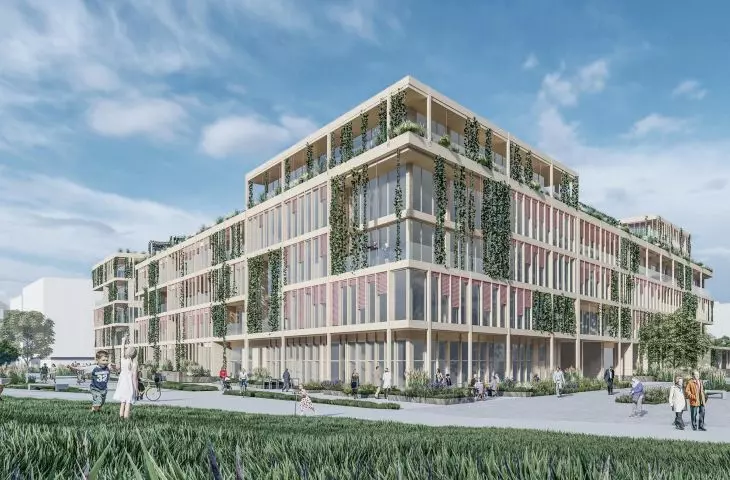Work submitted to the Halina Skibniewskaya student competition - HEALTHY HOUSE
Urban Pill is a project that is a comprehensive response to the needs of the modern urban community. It is a "prescription" for the diseases facing the city. The subject of the study is a multi-family residential building located in Krakow at Bohaterów Września Housing Estate.
The Uran Pill project by Ada Wolarek and Michalina Zyga was developed at the Faculty of Architecture of the Cracow University of Technology under the direction of Dr. Damian Poklewski-Koziel.
Urban Pill could be built in Krakow's Bohaterów Września housing estate street
© Ada Wolarek, Michalina Zyga
location
The building was created as part of a project for a new housing development forming the northern "edge" of the city. This required the development of a self-sustaining space, in which the overriding goal was to respect the existing social and natural environment and enrich it with new functions. The need to create a city within a city resulted in an urban planning concept based on the idea of a "15-minute city." The structure and diversity of functions of the new settlement makes it accessible to pedestrians and cyclists.
projection of a section of the housing development
© Ada Wolarek, Michalina Zyga
The entire transportation infrastructure has been adapted to the prevailing pedestrian traffic, and its course to the terrain. Vehicular traffic has been moved underground, leaving space on the surface for public transportation, access to residents' parking lots, bicycle paths and various forms of city squares.
The multifamily development quarter under development has been designed with the idea of
about creating a healthy, friendly residential environment
© Ada Wolarek, Michalina Zyga
An important aspect of the concept was also to connect the new section of the city with the surrounding neighborhoods of Mistrzejowice. This connection was provided by extending the Champejowice Planty - a green belt seamlessly connects the old and new developments, as well as the Zesławice Reservoir and Krakow's forts. In this way, the wild meadows were used as a common, recreational and social space, protecting the valuable area from possible development.
interior of the quarter and usable roof
© Ada Wolarek, Michalina Zyga
multi-family house
The developed quarter of multifamily housing was designed to create a healthy, friendly residential environment. The building fits into the overall guiding idea of the urban design - the idea of a pedestrian-accessible city, by introducing diverse functions into the designed fabric.
ground and second floor plan
© Ada Wolarek, Michalina Zyga
A healthy neighborhood is first of all healthy houses. When designing, many aspects were taken into account, both social and environmental. The building uses collected rainwater and solar energy from cells mounted on the highest part of the roof. The apartments have been positioned so that, as much as possible, they receive light, and most of the designed apartments have ventilation.
Sun blinds create the character of the development
© Ada Wolarek, Michalina Zyga
Sun blinds create the character of the development, but most importantly they give residents the opportunity to protect their rooms from excess sunlight. Depending on the weather, the facades will always look different, as the residents themselves have an influence on their appearance. In addition, each apartment has access to a balcony, terrace or its own garden.
cross-section A-A
© Ada Wolarek, Michalina Zyga
The post-pandemic situation has affected how to design, especially residential buildings. They should be flexible and respond to the changing needs of residents. To this end, the building was designed using CLT technology. The post-and-panel construction using Spider Rothoblaas connectors allows for appropriate use of space and economical use of raw materials, so the materials also contribute to creating a healthy climate in the interiors. Walls made of CLT panels are used to separate apartments and rooms, which allows any arrangement of the building. Thinking of all users, at least one independent apartment for people with disabilities has been designed on each floor.
A pedestrian walkway overlooking Mistrzejowice
Ada Wolarek, Michalina Zyga
The diverse residential structure is also accompanied by social spaces - in the form of a day care center for children, a coworking zone and catering establishments. Also envisaged are common areas dedicated exclusively to the quarter's residents - usable green roofs and a residents' club. On the first floor of each building, bicycle storage rooms have been located - the freedom to store bicycles is intended to encourage tenants to use them on a daily basis, as well as parcel machines, as a response to satisfying further needs of residents.
In order to properly prioritize space, both private and semi-private zones and public zones have been created. The seamless transition between the two affects daily life among the buildings and encourages neighborhood ties.
Ada Wolarek, Michalina Zyga
Illustrations: © Authors



















































































